I am glad that they have finally noticed. It is completely resonable to expect the two poles to be linked with the increase in one been offset by the decrease in the other.
Rather important not?. All this points to variations induced through the Antarctic Circumpolar Current. I do think that we have a slow pulse that rotates around the Antarctic every thousand years or so. This induces a flow change in the deep currents adjusting the gulf Stream in particular. It is not that much but enough to make a difference that balances the global heat content.
This all makes the global warming hypothesis completely bogus as this alternative explains all the real change we have noticed.
NASA: Antarctic sea ice is growing, but we don’t know why
https://tallbloke.wordpress.com/2021/02/01/nasa-antarctic-sea-ice-is-growing-but-we-dont-know-why/
Antarctic sea ice [image credit: BBC]
Warming, but not global – is the polar see-saw hypothesis in play here? In any case, it seems climate models are falling short again.
– – –
Sea ice in the Southern Ocean defies predictions.
Observations show that ice extent in the Antarctic has been growing slightly, reports The Global Warming Policy Forum (GWPF).
Paul Holland, a climate modeler with the British Antarctic Survey, has spent the last ten years studying Antarctica’s sea ice and the Southern Ocean.
Lately, he has been scrutinizing the seasons of Antarctica and how fast the ice comes and goes.
Holland thinks these seasons may be a key to a conundrum: If Earth’s temperatures are getting warmer and sea ice in the Arctic has been shrinking fast, why then is sea ice in the Antarctic slowly increasing?
Opposite poles
Sea ice is simply frozen seawater. Although found only in the Arctic and the Antarctic, it influences Earth’s climate in big ways. Its bright surface reflects sunlight back into space. Icy areas absorb less solar energy and remain relatively cool.
When temperatures warm over time and more sea ice melts, fewer bright surfaces reflect sunlight back into space. The ice and exposed seawater absorb more solar energy and this causes more melting and more warming.
Scientists have been watching this feedback loop of warming and melting in the Arctic. To them, Arctic sea ice is a reliable indicator of a changing global climate. They pay the most attention in September when Arctic sea ice shrinks to its smallest extent each year. Measured by satellites since 1979, this minimum extent has been decreasing by as much as 13.7 percent per decade.
Antarctic sea ice, on the other hand, has not been considered a climate change indicator. Whereas Arctic sea ice mostly sits in the middle of land-locked ocean—which is more sensitive to sunlight and warming air—Antarctic sea ice surrounds land and is constantly exposed to high winds and waves.
According to climate models, rising global temperatures should cause sea ice in both regions to shrink. But observations show that ice extent in the Arctic has shrunk faster than models predicted, and in the Antarctic it has been growing slightly.
Researchers are looking much closer at Antarctica, saying, “Wait, what is going on down there?” Holland is one of those intrigued.
“The Antarctic case is as interesting as the Arctic case,” Holland said. “You can’t understand one without understanding the other.”
Minding the models

No comments:
Post a Comment